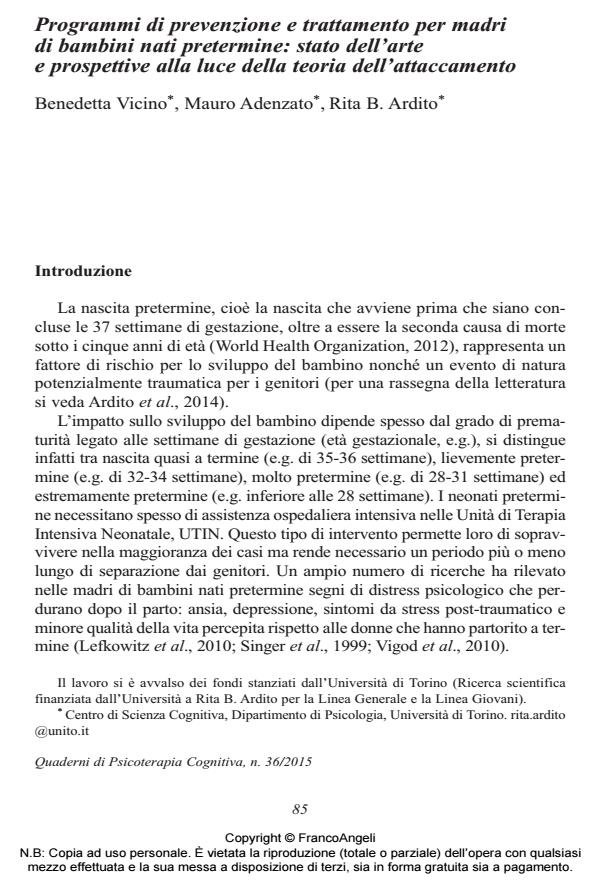Programmi di prevenzione e trattamento per madri di bambini nati pretermine: stato dell’arte e prospettive alla luce della teoria dell’attaccamento
Titolo Rivista QUADERNI DI PSICOTERAPIA COGNITIVA
Autori/Curatori Benedetta Vicino, Mauro Adenzato, Rita B. Ardito
Anno di pubblicazione 2015 Fascicolo 2015/36
Lingua Italiano Numero pagine 18 P. 85-102 Dimensione file 131 KB
DOI 10.3280/QPC2015-036007
Il DOI è il codice a barre della proprietà intellettuale: per saperne di più
clicca qui
Qui sotto puoi vedere in anteprima la prima pagina di questo articolo.
Se questo articolo ti interessa, lo puoi acquistare (e scaricare in formato pdf) seguendo le facili indicazioni per acquistare il download credit. Acquista Download Credits per scaricare questo Articolo in formato PDF

FrancoAngeli è membro della Publishers International Linking Association, Inc (PILA)associazione indipendente e non profit per facilitare (attraverso i servizi tecnologici implementati da CrossRef.org) l’accesso degli studiosi ai contenuti digitali nelle pubblicazioni professionali e scientifiche
La nascita pretermine e la seconda causa di morte sotto i cinque anni di eta e rappresenta un fattore di rischio per lo sviluppo del bambino e un evento di natura potenzialmente traumatica per i genitori. L’obiettivo del presente lavoro e presentare alcuni programmi di prevenzione e trattamento che si rivolgono in modo privilegiato alle madri di bambini nati pretermine, la cui efficacia e stata dimostrata e che siano stati sviluppati all’interno della cornice teorica dell’attaccamento. Nel complesso, i programmi presi in considerazione mostrano una certa efficacia nel migliorare la qualita della relazione madre-bambino, favorire lo sviluppo del bambino e migliorare il distress psicologico dei genitori. Tuttavia la comprensione dei meccanismi di funzionamento sottostanti, il ruolo da attribuire ai diversi fattori protettivi e di rischio e il modo in cui integrare tutto cio in un programma di prevenzione e trattamento efficace rimangono questioni aperte. Proponiamo che un contributo in tal senso deriverebbe da una maggiore considerazione dello stato della mente materno rispetto all’attaccamento nella progettazione e nella realizzazione di questi programmi: declinare l’intervento in base alle specifiche caratteristiche materne favorirebbe il raggiungimento di esiti positivi per la madre, per il bambino nato pretermine e per la loro relazione.
Parole chiave:Attaccamento, nascita pretermine, prematurita, prevenzione, programmi di intervento.
Benedetta Vicino, Mauro Adenzato, Rita B. Ardito, Programmi di prevenzione e trattamento per madri di bambini nati pretermine: stato dell’arte e prospettive alla luce della teoria dell’attaccamento in "QUADERNI DI PSICOTERAPIA COGNITIVA" 36/2015, pp 85-102, DOI: 10.3280/QPC2015-036007